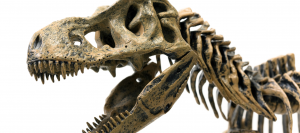Imagine walking into a luxury listing — the glimmer of exquisite chandeliers, the smell of freshly-cut flowers and hand-crafted candles, a picture-perfect view of a private beach or bay, and a dinosaur?
According to recent reports in the Wall Street Journal and National Geographic, luxury homeowners and buyers are showing interest in dinosaur fossils as one-of-a-kind fixtures sure to spark interest and envy.
“Private fossil collectors are pretty common these days,” National Geographic reporter Richard Conniff writes in the October issue of the magazine. “Some are serious enough to pass for professional paleontologists. The passion for paleontology among private collectors means that dinosaurs and other fossil giants can turn up in homes and businesses almost anywhere.”
Conniff found private collectors in the United States, Europe, and Asia with some shelling out millions for authentic full-body fossils of Allosauruses, Ichthyosauruses, Stegosauruses, and Tyrannosaurus Rexes.
“I was amazed by these dinosaur skeletons in the middle of New York,” Henry Kriegstein told Nat Geo while standing under a 17-foot-long Mosasaur suspended in his bay-side living room.
Kriegstein said the investment in the Mosasaur was worth it as it gave him and his family “a very spiritual feeling of connection with the history of life.”
 An unfair competitive advantage
See how EXIT Realty was first to what the world’s most powerful business leaders only just understood READ MORE
An unfair competitive advantage
See how EXIT Realty was first to what the world’s most powerful business leaders only just understood READ MORE
Another collector, who remained anonymous, said his recent purchases of two full skeletons and a skull wouldn’t be on display in his main residence. Instead, he’d display them in his private museum located on his Tucson, Ariz. estate.
Homeowners aren’t the only ones interested in the giant reptiles that once ruled the Earth — a real estate developer is hoping a $1.5 million Allosaurus will make his newly-built $37.95 million Beverly Hills mansion stand out in an uber-competitive Los Angeles luxury market.
The 12,500-square-foot home has five bedrooms, a wellness center with a sauna and steam room, a movie theater and game room, a 1,000-foot-long driveway, and 10,000 square feet of outdoor space opening to a pristine view of downtown LA.
Even with all of those features, developer Tim Ralston of MLR Development thought the home still needed a special touch.
“It seems like there is a desire among some of these high-end homeowners to have a distinctive visual feature as a focal point of the home,” Ralston told the Journal.
Ralston partnered with a private collector to borrow the 155-million-year-old dinosaur, which is carefully placed in the entry hall underneath a dazzling array of golden orbs hanging from the ceiling.
The Allosaurus isn’t included in the $37.95 million price tag, but it can be bought separately, explained listing agent Stefan Pommepuy of The Agency.
“We’re launching it today, and today is our big twilight VIP event, so we haven’t actually taken buyers through the space just yet,” Pommepuy added during a phone call with Inman.
“But based on feedback, people find it intriguing, cool, innovative and sexy.”
Although eye-catching, maintaining an authentic dinosaur skull or skeleton takes plenty of work, and paleontologists often worry that inexperienced collectors may damage fossils.
Furthermore, the trend has also the fueled counterfeit fossil market and has opened the door for authentic fossils to be illegally excavated and sold on the black market.
“Assorted scandals—faked specimens from China, illicitly smuggled dinosaur bones from Mongolia, and careless or illegal excavations everywhere—have sustained the hostility of some academic paleontologists toward private collectors,” according to the National Geographic report. “So has the tendency to treat precious fossils merely as aesthetic objects, or worse.”
With that in mind, some paleontologists and curators have begun to work with private collectors — teaching them the tricks of the trade and even convincing them to donate their fossils to museums — in exchange for a tax deduction, of course.
“Dinosaurs are ‘not really conducive to the home environment and are not easy to dust,’” one curator told National Geographic.
Source: click here














